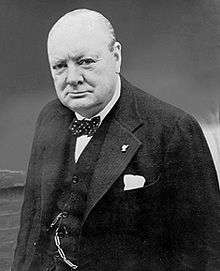Arcadia Conference
The First Washington Conference, also known as the Arcadia Conference (ARCADIA was the code name used for the conference), was held in Washington, from December 22, 1941 to January 14, 1942.
It brought together the top British and American military leaders in Washington, December 22, 1941, to January 14, 1942. Winston Churchill and Franklin Roosevelt and their aides had very candid conversations that led to a series of major decisions that shaped the war effort in 1942-1943. The decision was made to invade North Africa in 1942, to send American bombers to bases in England, and for the British to strengthen their forces in the Pacific. The Conference established the Combined Chiefs of Staff, headquartered in Washington, which approved and finalized all military decisions. The conference also created a unified American-British-Dutch-Australian Command (ABDA) in the Far East; the ABDA fared poorly. Finally the conference drafted the Declaration by the United Nations, which committed the Allies to make no separate peace with the enemy, and to employ full resources until victory.[1]
Arcadia was the first meeting on military strategy between Britain and the United States; it came two weeks after the American entry into World War II. The Arcadia Conference also had a wider international diplomatic and political aspect concerning the terms of the post-war world, which followed from the Atlantic Charter, agreed between Churchill and Roosevelt in August 1941. On January 1, 1942, 26 governments attending the conference agreed to the Declaration by United Nations.[2]
Although Roosevelt was under some domestic pressure to concentrate the United States war effort on Japan because of its attack on Pearl Harbor on December 7, Germany's declaration of war made this decision more politically acceptable to opinion in the United States than it would otherwise have been. With these developments, the United States government agreed that to win the war, the prime objective was the defeat of Nazi Germany. This was termed the Europe first strategy. It was also agreed at the conference to combine military resources under one command in the European Theater of Operations (ETO).[3]
Participants
- British Officers
- Admiral of the Fleet, Sir Dudley Pound, First Sea Lord and Chief of Naval Staff
- Field Marshal Sir John Dill
- Air Chief Marshal Sir Charles Portal, Chief of Air Staff
- Admiral Sir Charles Little, Joint Staff Mission
- Lieut. General Sir Colville Wemyss, Joint Staff Mission
- Air Marshall A. T. Harris, Joint Staff Mission
- U. S. Naval Officers
- Admiral H. R. Stark, Chief of Naval Operations
- Admiral E. J. King, Commander-in-Chief, U. S. Fleet
- Rear Admiral F. J. Horne, Assistant Chief of Naval Operations
- Rear Admiral J. H. Towers, Chief, Bureau of Aeronautics
- Rear Admiral R. K. Turner, Director, War Plans Division
- Major General Thomas Holcomb, Commandant, U. S. Marine Corps
- U. S. Army Officers
- General George C. Marshall, Commanding General of the Field Forces and Chief of Staff, U. S. Army
- Lieut. General H. H. Arnold, Chief of the Army Air Forces and Deputy Chief of Staff, U. S. Army
- Brigadier General L. T. Gerow, Chief of War Plans Division
- Joint Secretaries
- Captain J. L. McCrea, Aide to Chief of Naval Operations
- Lieut. Colonel P. M. Robinett, G-2, GHQ, U. S. Army
- Major W. T. Secton, Assistant Secretary, W.D.G.S.
See also
- Diplomatic history of World War II
- Washington Conference
- List of World War II conferences
- U.S.-British Staff Conference (ABC-1) - the staff meeting that laid the groundwork for this political meeting.
- Second Washington Conference
- Third Washington Conference
References
- ↑ William Hardy McNeill, America, Britain and Russia: Their Cooperation and Conflict 1941-1946 (1953) pp 90-118
- ↑ Joint Declaration by the United Nations of January 1, 1942.
- ↑ Powaski, Ronald E. (1991). Toward an entangling alliance : American isolationism, internationalism, and Europe, 1901-1950. Greenwood Press. p. 112-14. ISBN 9780313272745.
Further reading
- McNeill, William Hardy. America, Britain and Russia: Their Cooperation and Conflict 1941-1946 (1953) pp 90–118
- Matloff, Maurice, and Edwin M. Snell. Strategic Planning for Coalition Warfare 1941-1942. Washington (1953) Chapter V and Chapter VI
External links
- Conferences of the Allied Grand Strategy by Steven Schoenherr
- World War II Timeline by Steven Schoenherr
- This Day in History January 1 - The History Channel
- "Proceedings of the American-British Joint Chiefs of staff Conferences" (PDF). Washington, D.C. December 24, 1941 – January 14, 1942. Retrieved 2014-07-21.
